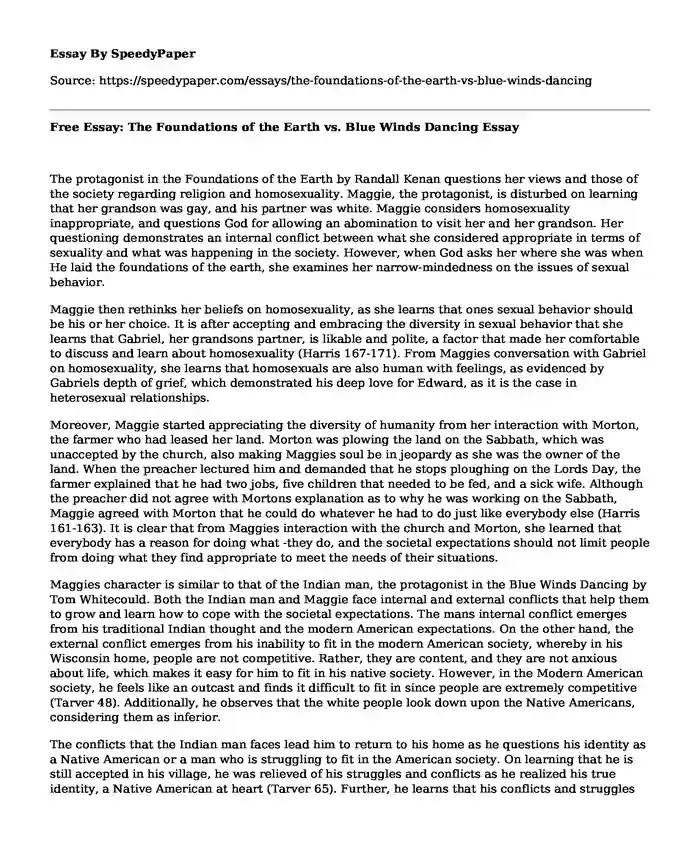
| Type of paper: | Essay |
| Categories: | Literature |
| Pages: | 3 |
| Wordcount: | 811 words |
The protagonist in the Foundations of the Earth by Randall Kenan questions her views and those of the society regarding religion and homosexuality. Maggie, the protagonist, is disturbed on learning that her grandson was gay, and his partner was white. Maggie considers homosexuality inappropriate, and questions God for allowing an abomination to visit her and her grandson. Her questioning demonstrates an internal conflict between what she considered appropriate in terms of sexuality and what was happening in the society. However, when God asks her where she was when He laid the foundations of the earth, she examines her narrow-mindedness on the issues of sexual behavior.
Maggie then rethinks her beliefs on homosexuality, as she learns that ones sexual behavior should be his or her choice. It is after accepting and embracing the diversity in sexual behavior that she learns that Gabriel, her grandsons partner, is likable and polite, a factor that made her comfortable to discuss and learn about homosexuality (Harris 167-171). From Maggies conversation with Gabriel on homosexuality, she learns that homosexuals are also human with feelings, as evidenced by Gabriels depth of grief, which demonstrated his deep love for Edward, as it is the case in heterosexual relationships.
Moreover, Maggie started appreciating the diversity of humanity from her interaction with Morton, the farmer who had leased her land. Morton was plowing the land on the Sabbath, which was unaccepted by the church, also making Maggies soul be in jeopardy as she was the owner of the land. When the preacher lectured him and demanded that he stops ploughing on the Lords Day, the farmer explained that he had two jobs, five children that needed to be fed, and a sick wife. Although the preacher did not agree with Mortons explanation as to why he was working on the Sabbath, Maggie agreed with Morton that he could do whatever he had to do just like everybody else (Harris 161-163). It is clear that from Maggies interaction with the church and Morton, she learned that everybody has a reason for doing what -they do, and the societal expectations should not limit people from doing what they find appropriate to meet the needs of their situations.
Maggies character is similar to that of the Indian man, the protagonist in the Blue Winds Dancing by Tom Whitecould. Both the Indian man and Maggie face internal and external conflicts that help them to grow and learn how to cope with the societal expectations. The mans internal conflict emerges from his traditional Indian thought and the modern American expectations. On the other hand, the external conflict emerges from his inability to fit in the modern American society, whereby in his Wisconsin home, people are not competitive. Rather, they are content, and they are not anxious about life, which makes it easy for him to fit in his native society. However, in the Modern American society, he feels like an outcast and finds it difficult to fit in since people are extremely competitive (Tarver 48). Additionally, he observes that the white people look down upon the Native Americans, considering them as inferior.
The conflicts that the Indian man faces lead him to return to his home as he questions his identity as a Native American or a man who is struggling to fit in the American society. On learning that he is still accepted in his village, he was relieved of his struggles and conflicts as he realized his true identity, a Native American at heart (Tarver 65). Further, he learns that his conflicts and struggles emerged from his failure to look at reservation. Looking at reservation helped him to discover who he was since among his people, he did not stand out, and no one thought of him as being out of place as it was the case in the modern America.
However, Maggie and the Indian man differ in that while Maggie focused on rethinking her beliefs with regard to sexual behavior and religion, which affect the broader society, the Indian man focused on a journey of self-discovery. The Indian man sought to discover where he belonged, where his interests could fit in, and the environment that he was best suited without having to conform to the values and beliefs of the society. On the other hand, while Maggie learned to embrace the diversity of humanity, the Indian man learned to embrace reservation and embrace who one is rather than trying so hard to fit in environments and situations that one cannot fit into no matter how hard they try.
Works Cited
Harris, E L. Freedom in this village: twenty-five years of black gay men's writing, 1979 to the present. New York Berkeley, Calif: Carroll & Graf Distributed by Publishers Group West, 2005. Print.
Tarver, Paul, et al. Blue winds dancing: the Whitecloud collection of Native American art. New Orleans, LA: New Orleans Museum of Art, 2005. Print.
Cite this page
Free Essay: The Foundations of the Earth vs. Blue Winds Dancing. (2019, Nov 08). Retrieved from https://speedypaper.net/essays/the-foundations-of-the-earth-vs-blue-winds-dancing
Request Removal
If you are the original author of this essay and no longer wish to have it published on the SpeedyPaper website, please click below to request its removal:
- Free Essay Example on Foreign Travel
- Management Essay Example on Business Analysis Process
- Internal Transfer Application, Essay Sample
- English Composition Assignment: Victorian and Modernist Literature. Free Essay
- Free Paper Example: Biographical Sketch of Augustine of Hippo (354-430)
- Gilded Age and Why It Was a Violent Time - Free Essay Example
- Essay Sample. CS IT Security and Disaster Recovery Management
Popular categories




